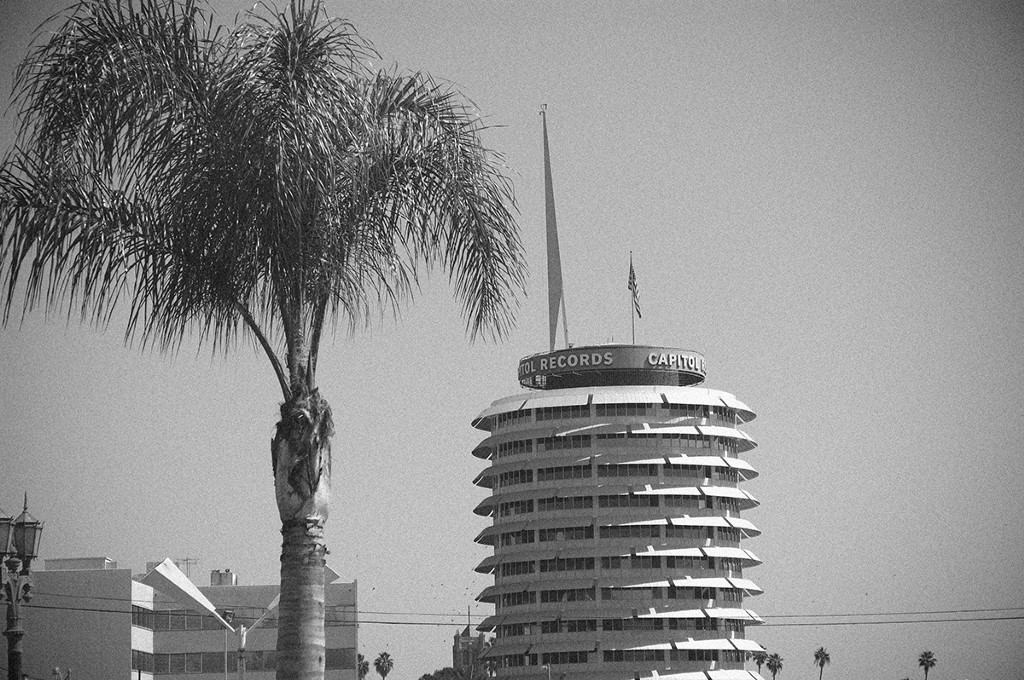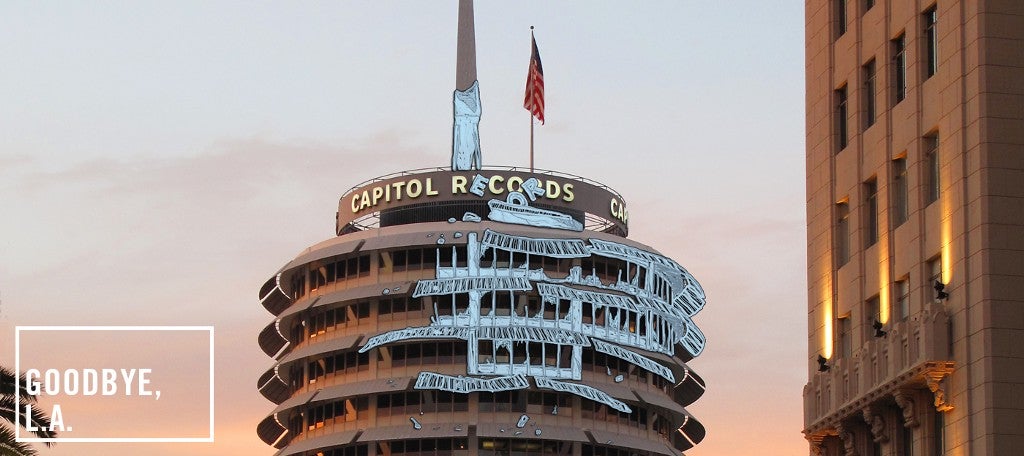MEL asked writer Ryan Bradley to tour Los Angeles, imagining what we might lose after the Big One strikes. Read the entire series here.
The big stack of records with the needle on top used to be there, soaring beside us on our way into or out of town. It was near the same old pass the padres used on their way from one mission to the next. There was the record stack, but also, first, the other stack: The Stack, the Four Level Interchange, first in the world.
When it opened in 1953, The Stack was a sensation, internationally famous, in magazines, on postcards. It was like nothing else, and seemed to embody the idea of Los Angeles as a city not just for cars but for fast-moving cars headed in every direction all at once. The Stack’s key element was the way the curved ramps and levels allowed, with practice, the feeling of seamless merging, of heading east on the Harbor Freeway, for example, then careening north on the Hollywood Freeway. Banking fast and smooth at 50 mph could bring about something close to ecstasy, or at least deep auto-spiritual zen. Joan Didion, in Play It as It Lays, described the tragic hero of her novel merging onto The Stack “without once breaking or losing the beat on the radio.” After this triumph, “she was exhilarated, and that night slept dreamlessly.”
The first Stack paved the way for the second: the Capitol Records Tower, completed a few years after the freeway interchange opened. The two aren’t merely linked in likeness — in stackness — but in purpose. Both were made for motion. Both could not be fully enjoyed if you weren’t in a car, preferably at high speed, on a freeway. An impossible proposition now, post-quake.

Imagine walking up to a building made to be seen from a moving car. The first thing you’d notice is how it’s really not a very big building at all—that it’s a little building signaling big, like one of those people dancing and spinning a sign for a cellphone store at a busy intersection. In 1969, Ada Louise Huxtable, The New York Times’ architecture critic, wrote about this style of building, “a new scale created by the automobiles and a new, bold architecture of communication grasped by the car in motion.” The article was called “The Case for Chaos” and in it she called for an embrace of architecture that “would, in a sense, roll with the punches.”
Remember, if you can, the approach to the record tower coming south on the Hollywood Freeway from the offramp at Vine. Closing in on the building, its 13-stories turned cute than quaint and kind of funky, like a too-big bungalow. The shades on every floor that gave it a pleasing texture from afar obscured its height up close. It was a tallish building that didn’t seem very tall at all when you’re right underneath.
“It’s so cute!” said a friend I had brought to the tower one day while it was still standing. We walked around the building, or around the block and parking lots surrounding it. The view from the Hollywood Freeway was still the best, we both agreed. We’d grown up seeing his 90-foot stack spell out the word Hollywood in Morse code with the blinking red beacon at its point. Samuel Morse’s granddaughter Leila had even thrown the switch to light it up when the building first opened in 1956. But the spire wasn’t even what particularly stuck in our memory — it was the Christmas tree that dangled from the spire, which wasn’t a tree at all, just strings of 4,373 lights dangling from the needle, in the shape of a tree. It looked more like Christmas in California than nearly anything. That tree, like the circular building, was known as “the first of its kind” — which is a silly sort of designation for all the wacky buildings cropping up all over Hollywood in the early and middle 20th century.

What does that mean, the first of its kind? The first strings of lights to be in a tree-shape? On top of a building? That is circular? That it is the first string of lights to be attached to a spire the looks a little like a record needle and blinks out the word Hollywood in Morse code?
My friend who thought the building looked cute up close is an art historian and the son of an architect , and as we were walking away he said he was into how this building was doing its own thing, that that’s really probably the hallmark of a good L.A. building, its doing-its-own-thing-ness while gesturing in a semi-self-conscious way toward some larger notion of popular culture—in this case, records. And even better when that gesturing is particularly dumb or obvious, that the gesture here was to the thing that was made inside.
I’d been inside, and the studios looked like studios, which is to say there was nothing very interesting or exciting about them at all. Ditto the offices. What I really wanted to see was the echoey concrete bunkers guitar maker and player Les Paul had specially designed, 30 feet below the building, to maximize reverb. This was also where Brian Wilson had tooled around with a theremin for the ooo — WEEEEE — oooo-ooooooooo in “Good Vibrations.” That space, or the idea of it, seemed to me to have a deeper connection to specific sound creation than anything else. It was probably best that it couldn’t be seen and couldn’t be missed.
